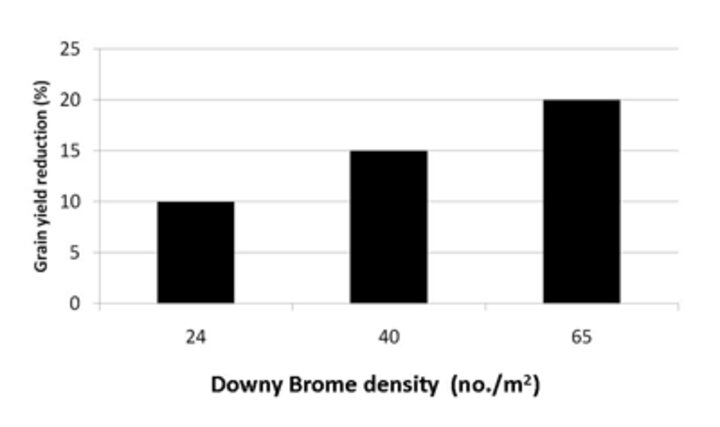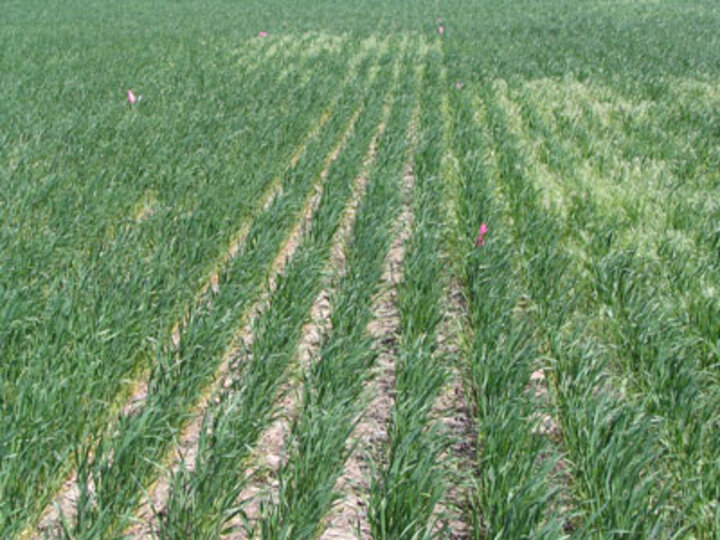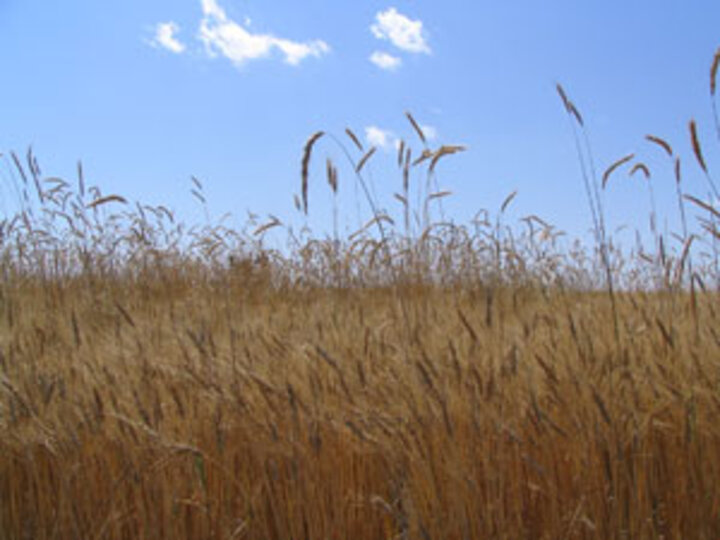September 25, 2009
Dry conditions in late summer followed by rainfall at, or shortly after, wheat seeding are now stimulating the germination of winter annual weeds. Stories in this week's CropWatch address fall control of winter annual broadleaf and grass weeds.

|
| Research conducted in Kansas and Wyoming found downy brome that emerges within 14 days of wheat emergence is the most competitive with winter wheat. Source: P. Stahlman and S. Miller. 1990. Weed Science Vol 38:224-228. |

|
|
Fall applications of Maverick, Olympus, or PowerFlex herbicides can provide excellent control of downy brome in winter wheat. Photographed in spring 2009, this wheat field near Sidney shows the effect of a fall application of Maverick herbicide (left) and a nontreated check (right). |
Winter annual grass weeds such as downy brome, jointed goatgrass, or feral rye can be more difficult to control in winter wheat than broadleaf weeds. Not only do these weeds compete with wheat for water, nutrients, and light, but in the case of jointed goatgrass and rye, their seed can contaminate grain and result in grain dockage and grade reductions.
Downy Brome. Maverick®, Olympus™ and PowerFlex™ herbicides provide selective control of downy brome and other Bromus species in winter wheat. These products provide similar control of downy brome. Fall applications usually result in better, more consistent control than spring applications. Growers should be aware of the rotation restrictions with these products. In general, PowerFlex has shorter crop rotation restrictions than either Maverick or Olympus; however, when it comes to proso millet — a common catch crop used when wheat fields are destroyed by hail or other causes — PowerFlex has a nine-month restriction compared to three and four months for Maverick and Olympus, respectively.
- Maverick should be applied at a rate of 2/3 oz/ac. A non-ionic surfactant should be added at 0.5% on a volume basis. Precipitation following application appears to be important for improved herbicide activity.
- Olympus herbicide should be applied at a rate of 0.9 oz/ac for downy brome control. A non-ionic surfactant should be added at a rate of 0.25% to 0.5% on a volume basis.
- PowerFlex should be applied at a rate of 3.5 oz/ac. Add a non-ionic surfactant at 0.25% to 0.5% on a volume basis.
Clearfield Wheat. Fields seeded to Clearfield wheat varieties, for example Infinity CL or Settler CL, can be treated with Beyond® herbicide to control downy brome, feral rye, and jointed goatgrass. Winter wheat cultivars that do not contain the tolerance gene are seriously injured or killed when treated with this herbicide. Fall and spring applications of Beyond have typically provided good to excellent control of jointed goatgrass and downy brome when treated with 4 ounces of product per acre. Postemergence applications require adding a surfactant at 0.25% and a nitrogen fertilizer solution at 2.5% on a volume basis.

|
| Feral rye is very competitive with winter wheat and can lead to reduced yields and significant grade reduction if feral rye seed contaminates grain. |
Rye Control. For the best control of feral rye, apply 5 ounces of Beyond per acre in the fall before the first rye tiller has emerged. Grower experience with Beyond for feral rye control has been inconsistent. Some growers have been pleased, some have been disappointed, and others have had both experiences. Until we have a better understanding of what is causing the inconsistent results, growers are advised to use conservative estimates for feral rye control when deciding whether to use the Clearfield® system in their operation.
Another option for controlling rye in winter wheat is to apply glyphosate with a rope-wick applicator. The rye should be 10 to 12 inches taller than the wheat for best results. In heavy stands of rye, travel in both directions. Remember that if you contact the wheat with the rope-wick or drip the herbicide on the crop, it will cause injury. Glyphosate should be mixed at a 33% concentration or 1 gallon of herbicide with 2 gallons of water. Surfactants may be needed for some glyphosate formulations.
Crop Rotation
If winter annual weeds are a regular problem in fields, change the crop rotation. Including a spring-seeded crop such as corn, sorghum, proso millet, or sunflower in the rotation with winter wheat and summer fallow provides an additional year to prevent seed production and allows the soil seed bank to gradually decrease.
Resource
More information on the control of winter annual weeds in winter wheat can be found in the Weed Management section of CropWatch – Wheat.
Drew Lyon
Extension Dryland Cropping Systems Specialist, Scottsbluff
Robert Klein
Extension Western Nebraska Cropping Systems Specialist, North Platte
